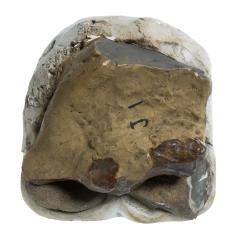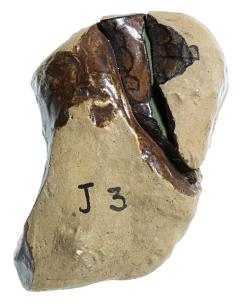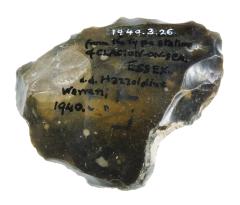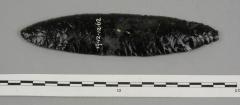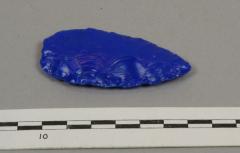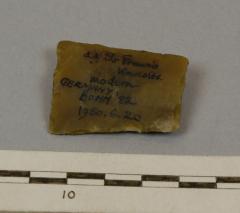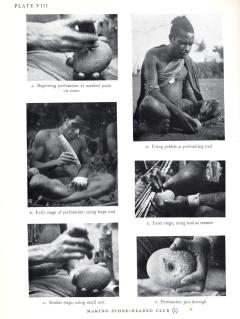ENGLAND: THE OTHER WITHIN
Analysing the English Collections at the Pitt Rivers Museum
Work on lithics in the Pitt Rivers Museum 1884-1985
Alison Petch,
Researcher 'The Other Within' project
The Annual Reports of the Pitt Rivers Museum have recorded the work that has taken place in the Museum on stone tool displays, research, and documentation since 1888 (the first annual report). This page lists most of the entries that occurred between 1884 and 1985 to give a flavour of the kind of work that has been carried out. Note that the 'I' or 'The Curator' mentioned in annual reports between 1888 and 1938 refer to Henry Balfour.1888 During the past year [1888] the work has been chiefly confined to the Upper Gallery, and the arrangement of specimens (Prehistoric sections, savage and other weapons) upon the wall screens, and in table cases, as well as in a few upright cases. ... A number of important additions are to be made to the Prehistoric series, by the transfer, from the Geological to the Anthropological Department, of a large number of Prehistoric implements, of the Stone and Bronze Ages, being a portion of the collection presented to the Museum by J. Wickham Flower, Esq.
1893 In the upper gallery a partial rearrangement of the Stone Implement series has been effected.
1896 In the upper gallery, a small series of palaeolithic implements, from Mr. Harrison’s collection, from the High Plateau of Kent, has been exhibited at the commencement of the Palaeolithic series. The fine series of Malay stone implements from the Straits Settlements, presented by Lieut.-Col. R. S. Frowd Walker, has been arranged in a special case.
1897 In the upper gallery there has been a rearrangement of the Palaeolithic series, and a six-drawer cabinet has been added for the non-exhibited material, allowing of a concentration of the material. A similar cabinet has been added to the Neolithic series. The labelling is to be continued. The Acton palaeoliths now occupy a separate case. At the east end, the series illustrating the working of flint, jade etc., has been rearranged in three cases and labelled; the series of forgeries of stone and other implements has been arranged in two cases and labelled, and is probably the most complete series of its kind the country. The Cissbury find has also been rearranged and partially labelled.
1900 A small but interesting series illustrating the Ancient Egyptian (Prehistoric Period) method of making armlets from flint or chert was mounted in a frame-case erected on the Gallery railing. The specimens were procured by Mr. H. Seaton-Karr.
1906 [Upper Gallery] A series of “pigmy” flint implements from various localities, a collection of flint saws, one of flint implements from the Zambesi River, and stone implements and pottery from Rhodesian ruins have been arranged in a special cabinet and labelled.
1908 [Upper Gallery] The stone implements of the Cave Period have been re-grouped, and numerous additions to this series have been made with a view to increasing its scientific interest. A glazed cabinet with exhibition case added has been placed in the upper gallery for the collection of stone implements from the Zambesi River, which I made in 1905 and 1907. The geological evidence points to many of these being of very high antiquity, and the correspondence in type between the Zambesi implements and those of the River-Drift period in Western Europe is remarkable. I have made a model of the Victoria Falls and the immediate neighbourhood, to illustrate the geological conditions under which the implements were found.
1909 The collection illustrating the implements of the Upper Palaeolithic periods (“cave” periods) has been rearranged and added to, rendering it more efficient as a teaching series. Similar work is being done in connexion with the Lower Palaeolithic periods, involving a redistribution of the exhibited and non-exhibited material.
1910 The collection of stone implements belonging to the Cave Period from the Dordogne, given by Mr. D. Jenness, forms a valuable accession to the prehistoric series. It is satisfactory to note that Mr. Jenness is a former student in the Museum, having taken the diploma in Anthropology. Professor E. B. Poulton has given the whole of his very fine series of palaeo-lithic implements collected in Priory Bay, Isle of Wight. This collection is an extensive one and contains many fine examples. The series of Tasmanian stone implements has been greatly increased in size and in scientific value by the addition to it of Professor Tylor's fine series. The collection is now one of the finest extant.
1911 My own researches have been mainly devoted to the remains of the Stone Age in S. Africa. In addition to my own material collected upon the Zambesi River and its tributaries, I have examined a very large collection of stone implements from S. Africa sent to me from the Museum at Kimberley for diagnosis. I am preparing a report upon these at the request of the Curator, Miss M. Wilman.
1913 During the Easter vacation, I visited the Dordogne district of Central France, and collected a large number of stone implements of various palaeolithic periods and from a number of sites. These have been added to the Museum series illustrating the 1ater palaeolithic cultures, which have been considerably reinforced. Important accessions to other sections of the early Prehistoric collections have also been made, involving sundry rearrangements of the series. The additions to the collections from the Swiss Lake-dwellings, and to the series of N. American stone implements are especially note-worthy. An interesting collection of small implements exhibiting delicate microlithic workmanship from Mauretania and Tunisia was purchased. A group of stone implements bas been brought together to exhibit, as far as the material allows, the highest technique of the various Stone-age periods.
1914 A large portion of the valuable collection of stone implements from South Africa, sent by the Museum at Kimberley for examination, has been reported upon by me and returned to Kimberley.
1915 In the Upper Gallery progress was made in the rearrangement of the Early Prehistoric series, which have greatly increased in extent and in scientific interest. The exhibited groups are being rendered more typical of the various periods, the non-exhibited material being placed in cabinets beneath the table-cases. The changes involved a great amount of re-labelling.
1916 Considerable progress was made with the rearrangement of the Prehistoric series in the Upper Gallery, the west end of which was nearly completed, though much remains to be done in connexion with the reserve collections in the cabinets
1917 Further work upon the Prehistoric Series was carried out
1918 Some progress was effected in re-grouping series of Stone-age implements, and many other minor changes have been made.
1919 Important progress was made in the rearrangement of series in the wall-cases of the upper gallery, and the rearrangement of the series of stone implements was continued.
1920 The Neolithic series was partly regrouped, and this work is still in progress
1921 I have been engaged in research work upon the very fine collection of Tasmanian stone implements formed by the late Mr. E. Westlake. This is by far the finest collection of its kind in the kingdom and will throw much light upon the status of the Tasmanians among Stone-age peoples.
1927 In the Upper Gallery, additional vertical exhibition-cases have been added over the table-cases. This has enabled me to exhibit adequately a very fine and representative series illustrating the hafting of stone implements. ... I have continued my detailed examination of the Westlake collection of Tasmanian stone implements, and have reached new and definite results involving the revaluation of the status of native Tasmanian culture.
1928 I continued my research-work upon Tasmanian stone implements, and I hope that this may be completed before very long.
1931 I have continued my research-work upon Tasmanian stone implements, and hope soon to be able to publish the results.
1932 Most of the table-cases at the east end of the upper gallery were rearranged, and this work will be continued in connexion with the general Prehistoric series. ... I have nearly completed a paper upon the Stone Implements of Tasmania
1933 Further progress was made in my study of the extensive collection of Tasmanian stone implements formed by Mr. Westlake.
1939-40 The Curator, ably assisted by Sir Francis Knowles and Mr. R. J. C. Atkinson, is rearranging the exhibition and storage of the Stone Age material in the upper gallery. A neutral-tone Irish linen which never fades was chosen as a background, after a world-wide search of Museums, and we were fortunate in ordering enough of it before the war started, as well as of material for padding all of the drawers in the cabinets below to prevent chipping of heavy and delicate specimens. Our disappointment at the delay in securing a magnificent collection of Palaeolithic material from the Musée de l’Homme was somewhat alleviated when we were able to get together the wonderful collection made by Professor Dorothy Garrod from her Mt. Carmel caves in Palestine, representative kits of tools, completely documented, from the Acheulean to the Natufian (Mesolithic). Moreover, Professor A. S. Barnes has supplied us with a considerable number of specimens to fill important gaps, and many well-executed drawings from his note-books of specimens which are unobtainable, and Mr. Hazzledine Warren has filled other large gaps. In certain places where we lack material Miss Blackwood has supplied the deficiency by photography, which both enables us to tell a fairly complete story, and reminds us of what we must try to collect when Europe is calmer. ... The new arrangement shows, first, the Lower Palaeolithic in Europe, followed by that of Asia, then of Africa. The same arrangement is continued until the Chalcolithic, and is then followed by parallels found among modern Stone Age peoples (e.g. Tasmanians, Bushmen, Oceanians, and American Indians), with the techniques of manufacture used by them, and experimental work at Brandon and ancient parallels, to which Mr. V. R. Edwards, gun flint maker of Brandon has largely contributed. While this complete rearrangement (though adhering to the comparative methods of General Pitt-Rivers and Professor Balfour) is continuing, the Curator has had to close the upper gallery to the public.
1940-1 Archaeology is past Ethnology, and its earlier part up to the invention of agriculture is fittingly taught here, in close connexion with the Department of Geology. Thanks to the great industry and generosity of Sir Francis Knowles and Professor A. S. Barnes, and to the help of Mr. A. D. Lacaille and Mr. S. Hazzledine Warren during the past year, we have added greatly to our collections and ability to teach this subject. A main source of strength is in our comparative material from peoples who were in the Stone Age at the time of their discovery by Europeans, and in our series illustrating techniques of working. Against this richness must be set some poverty in European material, mainly Mesolithic and Upper Palaeolithic, a gap which the Musée de l’Homme of Paris has promised in part to fill. Our friends can judge as well as we when the happy day will come. ... . Here they make flint implements under the direction of Professor Barnes ... Another notable collection has been arranged and mainly given by Professor Barnes. In three large table cases he has displayed, with printed explanations, a series of natural fractures stimulating human workmanship in flint and other stone, together with a set of drawings mounted on glass to illustrate and explain the features of a number of human flaking techniques which are being placed beneath the drawings. A place has been fitted in Museum House where he makes plaster casts and cut-out cardboard drawings mounted at an angle fill serious gaps in our teaching apparatus, and made as they are by a master of scholarship and technique, show our pupils essential facts of workmanship in an admirable way. The Museum is fortunate to claim his interest and devotion. He has been a perfect factory of specimens and equipment. Sir Francis Knowles and Mr. Atkinson have completed the arrangement comparing the Stone Age industries of different parts of the Old World, followed by a comparative series of native Stone Age industries of peoples who still used stone tools when they were discovered by Europeans. With the Curator, Mr. Atkinson is preparing a handbook and labels, and Miss Blackwood has filled empty places with excellent photographs. We wait now for wood to make screens for the accompanying maps, descriptions, and pictures. Knowles has prepared a census of our many thousand stone implements, and has made it possible for us to know what we have, where it is, and what we most need. He has also started the section on techniques with an exhibition of cores from which implements have been struck, classified according to the technique employed by the flint-worker, and the type of flake which is his objective. To accompany it, he has prepared a catalogue, finely illustrated in pen and ink and water colour, inspection of which teaches many facts of the craft of the ancient worker. ... We have been indebted to Professor Barnes for practical demonstration and teaching the way to make flint implements, and for introducing some of our students to a study of the characteristics of such implements when treated by statistical methods. The results were of great value in the study of our large Biddenham collection made by Sir Francis Knowles, and have been well described by one of our pupils, Mr. W. C. Brice. Professor Myres undertook special tuition in archaeology and Sir Francis Knowles in Native Industries for which we thank them.
1941-2 In the Upper Gallery removal of the false backs from the bow cases has enabled us to show the bows more clearly, and given us wood to make screens to illustrate and explain some of the previously arranged comparative series of ancient and modern Stone Age industries and of techniques. The former is mainly illustrated by photographs taken by Miss Blackwood from sources chosen by the Curator, who has also written the descriptive labels; the latter is partly illustrated with beautiful water-colour drawings by Sir Francis Knowles from which it is easy to understand the workmanship of the Stone Age makers. A good deal of the material for the exhibition on techniques was chosen by him while he was cataloguing the Seligman and other Stone Age collections. ... Extra lectures in the Curator’s course were given by Professor Barnes on the making of stone implements and the evolution of hand tools
1942-3 In one project that we have long had at heart we have made a beginning. The first of our Occasional Papers on Technology, edited by the Curator and Demonstrator, has been published for the Museum by the University Press, and can be obtained from the Museum at a cost of five shillings. This paper on ‘The Manufacture of a Flint Arrow-head by Quartzite Hammerstone’ is by Sir Francis Knowles, who used only the tools employed by ancient peoples and their modern primitive counterparts, of whose techniques he has a wide knowledge. The results of his work, including the hammer-stones, bone and antler pressure-flakers, stages of work, comparative material, and pictorial screen, form an addition to our series of Stone Age Techniques, preceded by an exhibition of specimens and illustrating showing the techniques of Edge-flake (Clacton), Topflake (Levallois), and Side-flake (prismatic) cores and the types of tools made from them, together with an unusually complete display of the Brandon industry. Screens and specimens illustrating Palaeolithic and Neolithic axe and adze-making are nearly ready, the material being largely taken from work and collections chosen by Sir Francis Knowles, and from specimens collected and observations and photographs made by Miss Blackwood in the interior of New Guinea. ... To the section on Techniques the Curator has added a display of the early metallurgy of copper and bronze, and in that on Industries of the Stone and Early Metal Ages has completed 26 screens with attendant exhibition of specimens and storage, making 33 exhibitions out of the 80 planned. So far these represent the Lower, Middle, and Upper Palaeolithic and Mesolithic in Europe, Asia, and Africa, the Neolithic and Chalcolithic in some parts of the Old World, and a beginning on the industries of peoples in a stone age when discovered by Europeans. Eight more are nearly ready, and about 20 are roughed out. Several tons of stone implements have been sorted and arranged, and so far 160 photographs chosen by the Curator and taken by Miss Blackwood, and 120 drawings in colour and pen and ink by the Curator and Sir Francis Knowles, have been framed and glazed by Mr. Walters, and exhibited.
1943-4 Nearly all of the large Westlake collection of about 12,000 stone implements is now in classified drawers, and about 5,000 other specimens are classified and distributed elsewhere, or roughly classified in closed packing cases in Museum House, so that for the time we can find them fairly quickly, and can ultimately move with speed, decency and cleanliness. ... In the Top Gallery 21 screens have been added to the archaeological series, making 54 in all out of a possible 80. Of these, 45 are so far devoted to Stone-Age Industries, and 9 to Stone-Age Techniques. These with the attendant exhibitions have completed our display of the ancient Stone Age in Europe, Asia, and Africa to the beginning of the use of metal, and have made a good start on the industries of peoples in a Stone Age when discovered by Europeans. Especially interesting are the Bushman exhibition with Mr. Dunn’s fine collection from Palaeolithic to modern times, the Tasmanian with the Westlake collection and Bock’s paintings and Woolley’s photographs from life, the Eskimo section, in which Miss Blackwood had the advantage of a good collection from early explorers of the North-West Passage, and the Mexican, for which we were able to buy a good archaeological series from the excavator. In the Technical section Sir Francis Knowles has added his study of the Palaeolithic and Neolithic axe and adze, and Miss Blackwood has shown full details of the making of stone adzes and club-heads from her work in central New Guinea. It remains to complete the Bronze Age in this gallery, and to show what may be called the grammar of the Iron Age in the Lower Gallery beside modern examples of primitive iron-working. The exhibition so far has shown that our principal needs are for specimens archaeologically attested in the European Upper Palaeolithic and Mesolithic, and in the general archaeology of China, India, and Western Asia, regions not well represented except for Professor Garrod’s splendid series from the Mt. Carmel Caves in Palestine.
1944-5 The exhibitions and screens in the Top Gallery now shew a pretty complete account of the Stone Age Industries in the world from the Lower Palaeolithic to the Chalcolithic. In this series, only New Guinea and South America remain to be completed before we begin a series on the Bronze Age. The section on Stone Age Techniques now includes the valuable Barnes exhibition of Natural Fractures simulating Human Technique, the Knowles exhibition of Clacton, Levallois, and Brandon (Edge-flake, Top-flake, and Side-flake) technique, and the Palaeolithic and Neolithic Axe, Miss Blackwood’s series on modern stone-axe and adze making, a complete Brandon exhibition, one shewing sawing and drilling, and another shewing modern attempts to reproduce ancient and primitive techniques by Glover, Flint Jack, Snare, Spalding, Edwards, Balfour, Barnes, Coutier, and Knowles. Sir Francis Knowles’s exhibition of “The Manufacture of a Flint Arrow-head by Quartzite Hammer-stone”, now published by the Museum, has had a most favourable reception throughout the world, and its sale has exceeded expectation. ... The Curator has entered and arranged the Bell Collection of some 3000 European Stone Age specimens
1945-6 Mr. Bradford has thus been able to sort and rearrange in storage under the exhibitions some 3,000 stone tools from the Near East, Great Britain, and Scandinavia, that they can be quickly found.
1946-7 Apart from activities already mentioned, Miss. Blackwood prepared screens of Photographs and notes and arranged the specimens representing South Amercian archaeology in the Top Gallery, thus completing our Exhibition of Stone-Age Industries.
1947-8 Sir Francis Knowles has continued his valuable work in selecting and arranging material for the Stone Age cases, and has completely arranged and classified the storage of the Upper Palaeolithic material under the exhibition cases. In spite of difficulties, work on exchange continues. Mr. Bradford selected a representative series of British, French, and Palestinian stone implements to show some of the main types from Lower Palaeolithic to Neolithic, and exchanged them with the National Museum of Southern Rhodesia for a type-series of their Stone Age implements, and chose as similar series for a future exchange with Mexico. Our collection made for exchange with the Denver Art Museum in Colorado has reached America, and we await the American Indian collection in return. We have asked the Musée de L’Homme in Paris to delay sending their Upper Palaeolithic collection until a whole floor can be sent, as we want to examine the whole lot, rather than a selection of types. In the meanwhile, however, among donations, Mr. H.V.V. Noone has greatly enriched our collection by a gift of French Upper Palaeolithic material collected by himself, and to this Professor Barnes has generously contributed. Some of the specimens have replaced those on show, and a special collection of burins arranged by Mr. Noone’s classification has been displayed in the Top Gallery.
1948-9 Sir Francis Knowles, after many years of effort, has now been able to present to the Museum a complete flint-knapper’s outfit from Brandon, including the block used by Mr. Frank Edwards, brother of Mr. V.R. Edwards, of the Coach and Horses Gun-Flint Works at Brandon in Suffolk.
1949-50 Professor H.V. Vallois, Director of the Institut de Paléontologie Humaine in Paris, who went over some of our archaeological series, especially the cases showing natural fractures arranged by the late Professor A.S. Barnes
1950-1 Sir Francis Knowles has unfortunately been ill for a considerable part of this year, so that students have been deprived of his unique teaching. We miss his company and the work that adds so much to the value of our Stone Age Collections.
1951-2 Our many friends throughout the world will be glad to know that during the past year an entirely new glass roof was put on to the main court of the Museum, and so at last we are able to remove for good the covers of waterproof cloth which hid so much of our valuable series of Stone Age Techniques and Industries.
1952-3 In our last report we were happy to announce that Sir Francis Knowles was improving in health, and beginning to come to the Museum, and we looked forward to his once more taking part in work on the collections and to his classes for students. But he died on 4 April of this year, and Lady Knowles did not long survive him, dying on 30 July. Obituary notices by Miss Blackwood in Nature, by the Curator in The Museums Journal, and by both in Man have summarized the considerable contribution made by Sir Francis both to Physical Anthropology and to the Archaeology and Ethnology of Stone Age peoples, and his forthcoming book in our series, Stone-Worker's Progress, will give an account of those contributions. Here we will do no more than say that he and Lady Knowles have been closely associated with the Museum as long as the oldest of us can remember, and have shown the kindest interest in all of us even to the most lately joined apprentice. A large section of the Museum will always testify to the importance of his work here, and those whom he taught here will remember how generous he was in the gift of his time and knowledge, and his character which developed in his pupils affection, respect, and a desire for hard work. His work will continue.
1960-1 Mr. Dennis Britton, of Pembroke College, Cambridge, and of Queen’s College, Oxford, joined our staff in April of this year in succession to Mr. J.S.P. Bradford. He did the Archaeological and Anthropological Tripos at Cambridge, and so is eminently suited to our Department of Ethnology and Prehistory, which treats these two as a continuous process, the present and past of the same subject. While working with Professor Hawkes he became especially interested in the techniques of basic arts and industries, and has already published or has in press useful articles on ancient metallurgy, working in conjunction with our own small laboratories and with the University Laboratory of Archaeology and the History of Art. He is an especially valuable recruit now that the Curator’s time is running out, because with him and Mr. Allen we have both an academic and a technical post which ensure that a subject for which this Museum has always been well known will continue with the younger generation, and that one of the most important contributions which this Museum makes, and exemplifies in its Occasional Papers on Technology, has received new life and vigour. Mr. Britton will work mainly on periods from the Neolithic to Iron Ages, and Mr. E.F. W. Baden-Powell, lately appointed as University Lecturer in Prehistoric Archaeology, a most welcome appointment, will teach and guide research in periods from the Palaeolithic to Mesolithic. Thus we now are up to full strength in Archaeology, as well as in Ethnology, where Dr. Butt and Dr. Burridge divide the field of work.
1963-4 Mr. Baden-Powell gave his course of lectures on the Palaeolithic and Mesolithic periods, together with practical classes for the handling of stone implements and for comparison of the arts and techniques of prehistoric times with those of the Eskimo and other recent cultures. An elementary class with tutorials on the identification of teeth and bones was also included. A joint arrangement with Mr. Britton enabled the students to see allied work in other departments in Oxford, including the Department of Geology, the Research Laboratory for Archaeology and the History of Art, and the Ashmolean Museum. Time was also found for a joint visit to Avebury and neighbouring monuments, and to Devizes Museum.
Mr. Baden-Powell has continued his work with Dr. Kenneth Sandford on the stone implements from the Oxford district and it is hoped that this investigation will throw light on Sir Francis Knowles’s ideas about ‘turning the edge’ of flints in Palaeolithic times, and that the results will be published soon. On the geological side, he has continued his work on the use of fossil marine shells for dating remains of Prehistoric Man and his implements, partly filling in unpublished detail from Britain and the Mediterranean, and partly with special reference to the African raised beaches and marine clays.
Mr. D. Britton lectured on the first village communities in the Old World in Michaelmas Term, the later Neolithic and Early Bronze Age in Europe in the Hilary Term, and The Origins of Civilization in the Near East in the Trinity Term, and gave tutorials throughout the year. During Michaelmas and Hilary Terms he held practical classes covering the Neolithic and Bronze Ages and in the Trinity Term on material culture relating to the origins of civilization, some in the Pitt Rivers Museum and some in the Ashmolean Museum. Practical work included visits to laboratories to see the application of the natural sciences to archaeological problems.
1967-8 Dr. Roe: Lecture courses and classes on The Old Stone Age and the Middle Stone Age (three terms), and Material Culture of the Old and Middle Stone Ages (three terms). External lectures include papers to the Prehistoric Society and to University College, London. Secretary, Palaeolithic and Mesolithic Research Committee of the Council for British Archaeology. Served on the Council of the Prehistoric Societv, Board of the Faculty of Anthropology and Geography, Member, Committee for Archaeology, Secretary, Sub-faculty of Anthropology, University of Oxford. Examiner, Diploma in Prehistoric Archaeology, 1968. External Examiner, M.Phil., University of London.
Field Research
1. British Upper Palaeolithic
Archaeological research on the Palaeolithic of the British lsles has yet to produce reliable radiocarbon dates: these may, however, soon be forthcoming as may pollen profiles of a number of relevant cave and open-site deposits.
The new laboratory mentioned under Laboratory Facilities above is now being operated by Mr. John B. Campbell, Jnr., a D.Phil. student, who is concurrently conducting field research into the Upper Palaeolithic of the British Isles. In March 1968 presumably Late Rissian pollen was isolated from Middle Palaeolithic loess samples from La Cotte St. Brelade, Jersey, Channel Islands. In June 1968 presumably Middle Weichselian pollen was isolated from the basal red silt of Wookey Hole Hyena Den, Somerset, in one test case. This same silt had yielded Middle/Upper Palaeolithic Mousteroid 'Proto-Solutrean' industry to Prof. Boyd Dawkins in 1859-63. Its pollen content of birch, pine, hazel and various grasses has now indicated an interstadial flora, perhaps part of the Upton Warren Interstadial Complex of c. 45,000 to c. 22,000 B.C. This is the first time that pollen has been successfully obtained from any Pleistocene cave deposit in Britain, excluding La Cotte St. Brelade which is, in palaeoecological terms, virtually on the Continent.
During the 1968 spring and summer field seasons excavations were conducted at the following four British Upper Palaeolithic sites: a second undisturbed Late Upper Palaeolithic open-site at Hengistbury Head (Hants.), the Creswellian cave-sites of Cathole (Gower, S. Wales) and Sun Hole (Cheddar, Somerset), and the 'Proto-Solutrean' cave-site of Badger Hole (Wookey, Somerset). In terms of artifacts Hengistbury Head was the most productive; a total of 1,747 flints was excavated of which 65 are tools, including backed blades, scrapers and burins. Samples for pollen and granulometric analyses were collected from all four sites. Samples for radio-carbon dating were collected from Hengistbury Head, Cathole and Badger Hole and have since been submitted to the British Museum for pre-treatment. It is hoped that all of these samples will prove productive, but in any event work will be resumed and finished at Hengistbury Head in April 1969 and additional excavations will probably be undertaken at cave-sites in Derbyshire Staffordshire. and South Wales in the summer of 1969.
1968-9 Mr. Baden-Powell has continued his laboratory research on the environmental archaeology of fossil man in Europe and Africa, and has further prosecuted his field research in Scotland and the North of England to establish the relationship between the retreat of the ice sheets, changes in sea level and the arrival of the first Mesolithic immigrants. His environmental studies are being used successfully for the relative dating of stone implements from Britain, Portugal and West and South Africa. Much useful information is being built up from the study of the changing climates, especially comparing the northern and southern hemispheres in the Atlantic region.
Dr. D. A. Roe: Having completed his teaching commitments in Michaelmas and Hilary terms, Dr. Roe proceeded to the United States for sabbatical leave, principally to carry out research on Lower Palaeolithic artifacts from Spanish and African sites held by the University of Chicago and the University of California at Berkeley, and on the metrical and statistical analyses of palaeolithic handaxes. He also studied British palaeoliths held by the Field Museum in Chicago and theUniversityMuseum in Philadelphia. Extra-muralactivities: Secretary of Palaeolithic and Mesolithic Research Committee (and of the Mesolithic Sub-committee), Council for British Archaeology. He also served on (1) Advisory Panel on Grants for Publication, C.B.A., (2) Council of the Prehistoric Society, (3) Editorial Board of new journal, World Archaeology.
Mr. D. Britton: Lecturing and tutorials on the Neolithic and Bronze Age of Europe and on archaeological techniques for the Diploma in Prehistoric Archaeology and for the Diploma in Ethnology. Began research for the full publication of the Isleham (Cambs.) find of Late Bronze Age metalwork.
1969-70 Mr. D. F. W. Baden-Powell continued work on the Palaeolithic collections held by the Museum, on the comparison of European stone artefacts with those of Africa and India in preparation for a book on the evolution of Stone Age techniques, and has further collaborated with Mr. J. B. Campbell on a study of the cultures of the late Ice Age in Britain.
The Stone Age Study-Laboratory in Norham Gardens is extending its scope, and the work of sorting, classifying, and recording more than 9,000 flint and stone artefacts (mainly Palaeolithic) from many countries goes on. A further 700 palaeoliths, mainly Clactonian,from Henley-on-Thames, have been added by Mr. R. J. MacRae to thc existing collection, which totals 4,600 artefacts from this site. This study-sample is now complete, and analysis can proceed. In addition 450 axes, tools and flakes from many British sites have been deposited by the same collector. Mr. Baden-Powell is dealing with over 4,000 specimens acquired from Ipswich Museum. These include assemblages from India (Todd), Palestine (Garrod), Egypt (Seton-Karr), Africa (O'Brien), and East Anglia and Lower Thames (Burchell).
Mr. D. Britton: In addition to his teaching duties in the field of neolithic and later prehistoric archaeology for the Diploma in Prehistoric Archaeology .... Dr. D. A. Roe. Having completed lecturing and teaching duties on the Old and Middle Stone Age for the Diploma in Prehistoric Archaeology, Dr. Roe made preliminary preparations for a major field research project on the British Lower Palaeolithic sites, in collaboration with a former student, Dr. C. G. Sampson. With a research grant from the Wenner-Gren Foundation for Anthropological Research, he visited East African and Zambian Lower Palaeolithic sites and began a study of the implements for publication under the auspices of Professor J. Desmond Clark and Mrs. M. D. Leakey.
1972-3 Mr. D. F. W. Baden-Powell in another year of active 'retirement' has continued his valuable voluntary work with the palaeolithic collections housed in the basement of 5 Norham Gardens. An important loan collection of Irish Mesolithic material from Ipswich Museum has been sorted, boxed, and stored, and collections of palaeoliths from Europe, India, and Africa have been brought up from the basement of the Examination Schools and stored in a more systematic way.
It is impossible to speak of the work on the palaeolithic collections housed at Norham Gardens without mentioning the name of R. J. MacRae who for a number of years now has devoted a great part of his spare time to working with Mr. Baden-Powell on the task of systematizing the storage, and who has also added considerably to the British palaeolithic collections from his own collecting trips.
During the year a good deal of experimental flint knapping has gone on at the hands of Mr. Baden-Powell, Mr. MacRae, and Peter Jones, and some preliminary work has been done on the production of a short teaching film.
1973-4 During the year under review the allocation of No. 60 Banbury Road was announced for the use of the Pitt Rivers Museum, and the benefaction made in June by Mr. Francis Baden-Powell of a capital sum of £10,000 to enable the University to make ready an annexe to the Pitt Rivers Museum to contain inter alia a Quaternary Research Centre in memory of his late father's sixteen years of teaching and research at the Pitt Rivers.
1974-5 Late in 1974, 60 Banbury Road was made available to the museum and conversion for occupation commenced in mid January 1975. The new Donald Baden-Powell Quaternary Research Centre was virtually complete and already in use before the end of June. The work of re-organization of study collections and of displays in the Upper Gallery has made good progress, but with so small a staff complement the work is bound to go slowly.
1983-4 Towards the end of the year, with the completion of much of the remedial work required, the centre of activity moved to the new building at 60, Banbury Road. Mr Morris, the display technician working on the archaeology exhibition, made his base there, using the facilities of the partially-equipped display-preparation and wood-working shops. Basic carpentry work on the first six display cases for archaeology was completed and progress was made with mounting in the first case, an introductory one which required much graphic and illustrative work. As far as possible material had been prepared in advance and items required from outside the Museum's own collection, such as photographs and casts, had been obtained. Mr Inskeep (Assistant Curator for archaeology) spent much time during the year on planning and preparation, and he and Mr Morris went to Cambridge to see the new archaeological exhibition in the University Museum of Archaeology and Anthropology, a comparable undertaking to that of the Pitt Rivers Museum but provided with relatively lavish resources.
As a direct result of his work on this exhibition Mr Inskeep found it necessary to check and rebox the very large L.S.B. Leakey collection of artefacts from east Africa.
1985-6 The hunter-gatherer gallery was designed and planned by Mr Ray Inskeep and mounted by Mr Ivor Morris, Mr John Simmons, and Mr Andy Munsch. It deals with the nature and extent of the archaeological evidence for man's hunting and gathering activities in various parts of the world from the earliest known periods down to the present day. The planning of the ethnographic displays dealing with the more recent period was carried out by Mr Ray Inskeep and Dr Donald Tayler and the displays were mounted by Mr Bob Rivers and Mr Ivor Morris.
